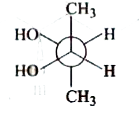Molecules whose mirror image is non-superimposable over them are known as chiral. Which of the following molecules is chiral in nature?
2-Bromobutane
1-Bromobutane
2-Bromopropane
2-Bromopropane-2-ol
The correct Answer is:A
To determine which of the given molecules is chiral, we need to identify if there is a chiral center (chiral carbon) present in each molecule. A chiral center is a carbon atom that is bonded to four different groups. If a molecule has a chiral center, its mirror image cannot be superimposed on it, making it chiral.
1. Identify the Molecules: We need to analyze the given molecules:
- A) 2-bromobutane
- B) 1-bromobutane
- C) 2-bromopropane
- D) 2-bromopropane-2-ol
2. Check for Chiral Centers: We will examine each molecule for the presence of a chiral center.
A) 2-bromobutane:
- Structure: CH3-CHBr-CH2-CH3
- The carbon atom at the second position (attached to Br) has four different groups:
- Methyl group (CH3)
- Ethyl group (CH2-CH3)
- Bromine (Br)
- Hydrogen (H)
- Since all four groups are different, 2-bromobutane has a chiral center and is therefore chiral.
B) 1-bromobutane:
- Structure: CH3-CH2-CH2-CH2Br
- The carbon atom at the first position (attached to Br) has:
- Bromine (Br)
- Two hydrogen atoms (H)
- Ethyl group (CH2-CH2)
- Since there are two hydrogen atoms, this carbon does not have four different groups. Therefore, it is not chiral.
C) 2-bromopropane:
- Structure: CH3-CHBr-CH3
- The carbon atom at the second position has:
- Two methyl groups (CH3)
- Bromine (Br)
- Hydrogen (H)
- Since there are two identical methyl groups, this carbon does not have four different groups. Therefore, it is not chiral.
D) 2-bromopropane-2-ol:
- Structure: CH3-C(Br)(OH)-CH3
- The carbon atom at the second position has:
- Two methyl groups (CH3)
- Bromine (Br)
- Hydroxyl group (OH)
- Again, since there are two identical methyl groups, this carbon does not have four different groups. Therefore, it is not chiral.
3. Conclusion: After analyzing all the molecules, we find that only 2-bromobutane has a chiral center and is chiral in nature.
Final Answer:
The chiral molecule among the options is A) 2-bromobutane.
- A) 2-bromobutane
- B) 1-bromobutane
- C) 2-bromopropane
- D) 2-bromopropane-2-ol
- Structure: CH3-CHBr-CH2-CH3
- The carbon atom at the second position (attached to Br) has four different groups:
- Methyl group (CH3)
- Ethyl group (CH2-CH3)
- Bromine (Br)
- Hydrogen (H)
- Since all four groups are different, 2-bromobutane has a chiral center and is therefore chiral.
- Structure: CH3-CH2-CH2-CH2Br
- The carbon atom at the first position (attached to Br) has:
- Bromine (Br)
- Two hydrogen atoms (H)
- Ethyl group (CH2-CH2)
- Since there are two hydrogen atoms, this carbon does not have four different groups. Therefore, it is not chiral.
- Structure: CH3-CHBr-CH3
- The carbon atom at the second position has:
- Two methyl groups (CH3)
- Bromine (Br)
- Hydrogen (H)
- Since there are two identical methyl groups, this carbon does not have four different groups. Therefore, it is not chiral.
- Structure: CH3-C(Br)(OH)-CH3
- The carbon atom at the second position has:
- Two methyl groups (CH3)
- Bromine (Br)
- Hydroxyl group (OH)
- Again, since there are two identical methyl groups, this carbon does not have four different groups. Therefore, it is not chiral.
The chiral molecule among the options is A) 2-bromobutane.
Topper's Solved these Questions
- HALOALKANES AND HALOARENESBOOK - NCERT FINGERTPS ENGLISHCHAPTER - HALOALKANES AND HALOARENESEXERCISE - Assertion and reason
15 Videos
- HALOALKANES AND HALOARENESBOOK - NCERT FINGERTPS ENGLISHCHAPTER - HALOALKANES AND HALOARENESEXERCISE - Polyhalogen Compounds
6 Videos
- HALOALKANES AND HALOARENESBOOK - NCERT FINGERTPS ENGLISHCHAPTER - HALOALKANES AND HALOARENESEXERCISE - Higher order thinking skills
8 Videos
- GENERAL PRINCIPLES AND PROCESSES OF ISOLATION OF ELEMENTSBOOK - NCERT FINGERTPS ENGLISHCHAPTER - GENERAL PRINCIPLES AND PROCESSES OF ISOLATION OF ELEMENTSEXERCISE - Assertion And Reason
15 Videos
- POLYMERS BOOK - NCERT FINGERTPS ENGLISHCHAPTER - POLYMERS EXERCISE - NCERT Exemplar
9 Videos
Similar Questions
Knowledge Check
Which of the following molecules are chiral ?
 AI, II, III and IVBII, III and IVCII and IVDI and II
AI, II, III and IVBII, III and IVCII and IVDI and IIWhich of the following molecules are chiral ?
 AI and IIIBI and VCII and IIIDII, III, IV
AI and IIIBI and VCII and IIIDII, III, IVWhich of the following molecules are chiral?
A B
B C
C D
D

